January 30th, 2013 § § permalink
“Comfort” in terms of restaurants is hard to define. There are plenty of neighborhood diners and the like serving up comfort food from meatloaf to frito pie, but for HG, a “comfort” restaurant has to have longevity (restaurant has been around a long time); old fashioned decor; professional waitpersons with long years of service; an unchanging menu. “Comfort” means a democratic approach. No special deference to big shots. No “Siberia.” Gage & Tollner (long closed) in Brooklyn met HG’s “comfort” criteria. So did the two (now closed) “dairy” restaurants on the Lower East Side — Ratner’s and Rappoport’s. As far as places that are still in existence, HG has three favorites. In Boston, it’s Durgin-Park. Very touristy and very plain spoken. HG likes to start with clams on the half shell. Then, a giant slab of rare roast beef (or chicken pot pie or grilled knockwurst with Boston baked beans). For dessert, New England Indian Pudding, natch. In Chicago, nothing beats Gene & Georgetti for old time Windy City flavor. Sirloin steak with a “Garbage” salad and fried onion rings. In San Francisco, Tadich Grill does the best Pacific seafood. HG has one or two Sloe Gin Fizzes at the bar. When seated at table, HG dives into a Dungeness crab cocktail, sauteed Petrale sole or the vast Cioppino, the incomparable seafood stew. A true New York “comfort” restaurant is Keen’s Chop House, home of the famed (giant) mutton chop. However, the prices at Keen’s continue to move upward so the eatery is barely in the “comfort” zone and has instead moved into masochist territory. With the guidance of SJ, HG is comforted at affordable Chinese restaurants in Manhattan, Flushing and the Sunset Park neighborhood of Brooklyn.
But wait…There’s a fourth. And, it truly defines the word “comfort.” Located in Italy, of course. HG refers to Bologna’s wondrous Ristorante Diana. A very old restaurant with a beautiful mirrored interior. Gentle lighting. Helpful (never obsequious) service. HG starts his meals there with a glass of Prosecco while contemplating the delights which will ensue. A bottle of Emilia Romagna’s red Sangiovese is uncorked. Then, a plate of tagliatelle dressed simply with butter and the best Parmigiano Reggiano. Using an instrument designed for the purpose, the waiter showers the pasta with shavings of white truffle. The heady fragrance fills the air and occupants of neighboring tables nod in approval. This is followed (and it is not an anti-climax) by Bollito Misto. For those unfamiliar, this refers to a variety of boiled and poached meats. At Diana, the Bollito Misto is served from a large trolley wheeled by a very large man. On the trolley are two poached sausages, Cotechino and Zampone, plus boiled beef, pork and tongue — all juicy and flavorful. This is accompanied by salsa verde and a pungent mostarda di frutta. Dessert is Semifreddo followed by a number of snifters of grappa (for digestive purposes). A brief stroll and a long nap is obligatory. True Comfort.

January 29th, 2013 § § permalink
The Blue Ribbon was a German restaurant located in New York on W. 44th Street between Sixth and Seventh Avenues. (Don’t confuse it with the cluster of wonderful Blue Ribbon restaurants run by the Bromberg brothers). The original Blue Ribbon opened in 1914 (and managed to survive the World War One anti-German hysteria). Delighted robust eaters for many decades until it closed in 1975. Served all the traditional dishes (kassler ripchen, grilled wursts, wiener schnitzel,sauerbraten, sauerkraut, fried potatoes, etc.). A warm room paneled in dark wood. Comfortable seats and pleasant lighting. A perfect venue for lovers of hearty food washed down with the best of German beers. It was a favorite with Germans who had fled Hitler. (Plus some bad Germans — namely a wartime espionage ring which used the restaurant as a rendezvous before being captured by the FBI). HG dined there very often with journalists from the New York Times. The real estate editor, the late Glenn Fowler, was a frequent dining companion. He introduced HG to steak tartare. Glenn would mix it at the table with a host of ingredients — egg yolks, anchovies, chopped onions, capers, English mustard, Worcestershire sauce, salt, ground pepper and a dash of Tabasco. Very memorable. Best ever. The Blue Ribbon was a short walk from the original Madison Square Garden (50th and 8th Avenue) so it was an HG favorite for a snack after basketball, hockey or fights. HG would choose the apple pancake, a giant affair, at least 18 inches in diameter, oozing sauteed apples enriched with cinnamon, ginger and powdered sugar. Dark beers in chilled mugs within reach, HG and buddies argued about the athletic events. A frequent Blue Ribbon customer was Erich Maria Remarque. His novel, All Quiet On The Western Front, was one of the first books burned by the Nazis. He manged to avoid their clutches by escaping to Switzerland (his sister, Elfriede Schutz, wasn’t as fortunate — she was beheaded by the Nazis for “defeatism”). There are many mentions of the Blue Ribbon in Remarque’s novel about New York in the 1940’s, Shadows In Paradise. Remarque didn’t spend all his time writing and eating. He had a long affair with Marlene Dietrich and a shorter affair with Hedy Lamarr before marrying the beautiful actress, Paulette Goddard. Remarque’s name lives on in New York. Goddard gave New York University $20,000,000 to found the Remarque Institute of European Studies. Permit HG a digression. The first director of the Institute was the late Tony Judt. In HG’s opinion, Judt is the greatest historian of post-World War Two Europe. He was an engaged intellectual who wrote many penetrating studies of world affairs. If you want to have some understanding of the difficult world we live in, you must read his books.
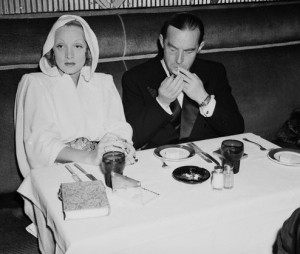
January 28th, 2013 § § permalink
BSK mixed five culinary cultures to create a comforting, harmonious meal for HG and BSK. It started with a three-egg omelette prepared in the classic French manner: Plenty of butter; gentle brown exterior and soft (the French describe it as “oozing”) interior. BSK filled this lovely creation with plenty of Greek feta cheese and a dusting of Mexican oregano. This was topped with a pork enhanced green chile sauce (spicy but not overpowering). BSK creates and freezes lots of this wonderful sauce every autumn. That’s when New Mexico green chiles are in season and the aroma of roasting chiles fills the Santa Fe air. Accompaniments were warmed corn tortillas (pita could have been substituted) and freshly made, fiery pico de gallo from the Pojoaque Super Market. Beverage was deep red Nero d’Avolo wine from Sicily. As a bow to the Orient, BSK and HG cooled their palates with a dessert of green tea ice cream. Ah, wouldn’t it be splendid if the world’s cultures could exist in the peaceful harmony they achieve in BSK’s kitchen?

January 27th, 2013 § § permalink
And, what are T-Ravs, you may ask? Well. they are Toasted Ravioli. Though described as “toasted,” these ravioli are, in fact, fried. They are a St. Louis treat, available in many of that city’s Italian restaurants and many other eateries. Yogi Berra, reared in St. Louis’ Hill neighborhood, said he missed the ravioli treat when his career brought him to New York, a big town with lots of ravioli but no T-Ravs. All of this was recalled by HG as HG read the obituary of the most illustrious of St. Louis citizens, baseball great Stan “The Man” Musial. HG once dined at his restaurant, Stan and Biggie’s, and had HG’s first and only experience with T-Ravs. They were okay but the real hit of the meal was an exemplary broiled calf’s liver with bacon and fried potatoes. Charred on the outside. Pink on the inside. Perfect. HG’s Mom made an Eastern European/Jewish version of ravioli — kreplach. Kreplach had thicker skins than ravioli and were filled with chopped beef and onions. Mom boiled them in her golden chicken soup with additions of noodles, kasha, boiled onions and carrots and mondels, airy little croutons. (In the absence of kreplach, the soup got matzo balls). As a special treat for little HG, Mom would retrieve some kreplach from the soup and fry them in chicken fat for lunch. The dish got a big hit of sour cream and lots of coarse salt and ground pepper. With apologies to the the memory of “The Man,” these beat the hell out of T-Ravs.

January 25th, 2013 § § permalink
HG and BSK had great fun spending part of each year year in a Vancouver loft (and then an ultra-modernist glass town house). A city of great architecture, mind boggling scenery, ethnic and cultural diversity. Posh skyscrapers and waterfront mansions; a nude beach; one section of town dominated by junkies and another (Commercial Drive) where the Sixties live forever. Much superior weed cultivated and smoked. Downsides: Rain. Homeless scavengers. Violent Indo/Canadian and Chinese drug gangs. Ridiculously high wine and spirits prices (because of taxes). For HG, the biggest plus was the food. The Public Market on Granville Island (and neighboring Island shops) is Foodie-Died-And-Gone-To-Heaven. There is such a large Asian population in Vancouver that locals refer to it as “Van Kong.” The neighboring city of Richmond is so Asian that New Yorkers may think of it as a vast Flushing. Obviously, this means there is a plenitude of Chinese restaurants. And, folks in Vancouver take Chinese dining seriously. So, while HG and BSK love their Southwestern life, they are pained when they read an article like the recent Vancouver Sun survey of its readership’s favorite Chinese dining experiences. Some 32,273 diners responded with glowing testimonials to such delicious treats as salt and pepper pork loin; Shanghainese pan fried buns; Taiwanese beef noodles; steamed Dungeness crabs; Stir fried prawns with eggs. Restaurants HG will try on next Vancouver visit: Fatty Cow Seafood (for hot pot); Sha Lin Noodle House (for noodles..what else?); Fisherman’s Terrace Seafood for dim sum; Hong Kong Barbecue Shop (for duck and pork). HG will not neglect his traditional favorites: Kirin. Congee Noodle House and Congee Noodle King. Chongquing Szechuan, Sun Sui Wah. Plus — Rodney’s for oysters and Vij’s for incomparable Indian fusion food.

January 24th, 2013 § § permalink
Good news. The venerable (opened in 1927) New York steak house, Gallagher’s, is not going to close. Found a last minute buyer. HG frequently lunched there (liked their sliced steak sandwich with sauteed onions and good French fries). Columnist/Novelist Jimmy Breslin was often at the bar. Gallagher’s was number three in HG’s ranking of New York steak eateries. Number one was the much missed Christ Cella (alas, long closed) and number two was Spark’s (still thriving). HG has never been fond of Peter Luger’s in Brooklyn. Overrated. Gallagher’s isn’t a charitable institution. They’re not giving food away. Sirloin steak is $46.95. Shrimp cocktail is twenty bucks and some sliced onion and tomato sets you back $14. Guess it’s all in line with New York apartment prices where a one room unit the size of a modest walk-in closet rents for $2,000 (or more) a month.
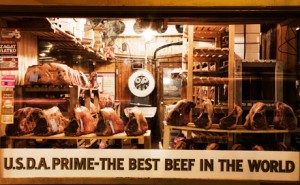
January 23rd, 2013 § § permalink
HG’s heart swelled a bit while watching the beautiful, elegant couple — Barack and Michelle — dance together at the Inaugural Ball. And, it followed the magnificent speech in which the President linked the battle for gay rights to this country’s ongoing efforts to achieve civil justice (sadly, much work has to be done). Memories were stirred: HG’s shock when, as a teenager, HG saw the omnipresent “Whites Only” signs in Atlanta. HG being physically assaulted when HG joined a picket line protesting the exclusion of an African-American war veteran from a New York swimming pool in 1946. HG in the 1948 student strike at CCNY which battled discriminatory practices at the College’s dormitory. HG’s shameful and reluctant acceptance, while a journalist in the early 1950’s, of the virulent racism in New York City law enforcement. On the brighter side: HG’s pride in meeting Martin Luther King and giving him strategic counseling concerning the civil rights movement and the Jewish community. And, most beautiful, the glow enveloping BSK when HG welcomed her back from Washington where BSK joined the historic March and heard Dr. King’s eloquent oration. HG and BSK watched the Inauguration and toasted the future. It all happened in one lifetime. Still hard to believe.
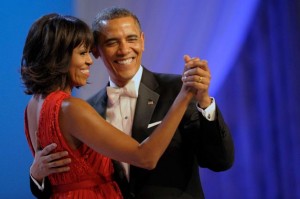
January 22nd, 2013 § § permalink
Manhattan’s Irving Place is a short street, occupying the six blocks between Gramercy Park and East 14th Street. It has a colorful history and, like many New York streets, has gone through many changes. Lots of memories for HG. Pete’s Tavern (corner of Irving Place and East 18th) was a favorite of HG’s. Wonderfully old fashioned bar and booths (owners claim it was founded in 1864 making it the oldest continually operating tavern in New York). Many an HG date started in a booth at Pete’s with the couple sipping the obligatory Martinis. Food was an afterthought but it was a perfectly acceptable place for a burger and a beer (however if you wanted a really delicious burger at an old fashioned bar, P.J. Clarke’s was the place). Pete’s had the reputation of being favored by literary types. Heavy drinking O.Henry (who lived nearby) made it his local and Ludwig Bemelmans sketched his first Madeleine tale on a Pete’s menu. According to HG’s informants, Pete’s decor remains virtually intact (you may have seen it on Seinfeld and Law & Order) but its clientele is mainly gawking tourists. Too bad.
For great dining on Irving Place knowing gourmands went to Paul and Jimmy’s Italian Restaurant. Paul and Jimmy Delgado (thus the name) opened the restaurant in 1950 and it had a great run for 18 years. The restaurant (under new ownership) moved from Irving Place to 123 E. 18th Street and is still in existence. HG has never been to the modern P & J so can’t vouch for the cuisine. But, the old Paul and Jimmy’s was pure delight (remains BSK’s favorite restaurant). It had all the traditional Italian delights — Mozarella in Carozza, Clams Oreganata, Clams Casino, Chicken Scarpariello, etc. Toothsome pastas. Paglia e Fiene (Hay and Straw) was always ordered by HG. This was a combination of thin spinach and egg pasta in a tomato cream sauce. Wonderful seafood including Whiting in Brodetto and a very unusual dish of striped bass poached in oil, vinegar and garlic. BSK recalls an very antic event at P & J’s: A rather large rat strolled in from the street. He sheltered under a table. Instead of panicking, the table of sophisticated New Yorkers made friends with the rodent and fed him various tidbits. A cook came rushing from the kitchen, cleaver in hand, with the intention of decapitating the rat. He was dissuaded. The rat, now full and happy, ambled back to the street and everyone in the restaurant (including HG and BSK) just kept on eating, drinking and laughing. Paul and Jimmy’s was that kind of happy place.
An interesting woman identified with Irving Place was Elsie de Wolfe (1865-1950), also known as Lady Mendl after her marriage in 1926 to Sir Charles Mendl. She lived in a town house on Irving Place with another interesting woman, Elizabeth Marbury. The Mendl-Marbury relationship (presumably lesbian) lasted some 40 years. Marbury was a pioneering theatrical agent with Oscar Wilde and George Bernard Shaw among her clients. Lady Mendl invented the profession of interior designer and revolutionized the way Americans furnished their homes with her book The House in Good Taste. Her revolutionary design style stemmed from the Mendl/ Marbury Irving Place town house. It was light and airy and filled with sunshine and her celebration of those qualities sounded the death knell for the heavy, fussy, super masculine decor of the Victorian era. The Mendl/ Marbury couple was prominent in New York society (the women were known as “the Bachelors”). When Society folks visited their town house, they fell in love with Lady Mendl’s interiors and her simple ability to (as she herself put it): “let the air and sunshine in.” At present there is a charming boutique hotel occupying two Irving Place town houses — The Inn at Irving Place. It contains the Lady Mendl Tea Salon. Lady Mendl would deplore the decor since it is resolutely Victorian. Ludwig Bemelmans (whom HG mentioned in connection with Pete’s) was a close friend of Lady Mendl and wrote a light-hearted memoir of her, “To The One I Love The Best.” HG particularly fancies Lady Mendl’s personal motto (embroidered on many pillows): “Never Complain, Never Explain.”
Irving Place also had a theatrical history. It was the site of the Irving Place Theater, a place which went through a multitude of changes. A young immigrant, Shmuel Goldfisch (later changed his name to Samuel Goldwyn) fell in love with theater when he saw ballet at the theater. He explained: “I went to the ballet because you didn’t have to understand English to know what was going on.” Later the theater became the venue of the Yiddish Art Theater headed by Maurice Schwartz (a thespian never famous for underacting). When the Yiddish actors weren’t treading the boards, the theater showed racy burlesque. During the 40’s and early 50’s, the theater showed Soviet propaganda films along the line of Boy Meets Tractors-Boy Loses Tractor-Boy Gets Tractor Back And Becomes Hero Of Socialist Agricultural Production. At the time, HG was a Man of the Left and should have enjoyed Soviet films. But, HG far preferred Louis Jouvet, Jean Gabin and Raimu. As for Maurice Schwartz, he made some Hollywood films. HG recognized him (complete with paint and a feather) as a very unconvincing Indian in a low budget Western.
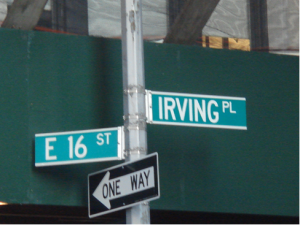
January 20th, 2013 § § permalink
Do you know what a Pupusa is? Okay, you food sophisticates out there might know all about them, but HG didn’t. And now that HG knows, HG is concerned for the unlucky folks who haven’t encountered this delight. So. A Pupusa comes from Central America (Salvador makes a specialty of this treat). It is a thick corn tortilla made of masada de maiz (maize flour dough). Pupusas are lightly fried and stuffed with a variety of ingredients — beans, cheese, chicken, chicharron ( a Salvadorian roast pork cooked to a paste-like consistency), etc., etc. Pupusas are usually served with curtido, cabbage slaw enhanced with vinegar and red chilis. They are mighty good (and very filling). They have some things in common with the Arepas eaten in Colombia and Venezuela and the Mexican Gordita. The Pupusa is better. Santa Fe is a great place for Pupusa consumption. The Tune Up Cafe makes some estimable Pupusas. But, the real shrine of these goodies is Pupuseria y Restaurante Salvadorena on Cerrillos Road. Some 16 Pupusas are on the menu. All spectacular. All priced at $2.50 each. Big time bargain. Lots of other Salvadoreno dishes are served. However, the big draw is the delicious and inexpensive Pupusa.
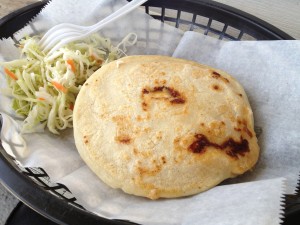
January 17th, 2013 § § permalink
An Arctic blast has the West in its frigid clutch. Last night the temp at HG’s New Mexico home was 3 degrees. Tonight it will get up to 7. Br-r-r!! The cure is chicken in the pot. And, lots of it. Back in the days when New York was filled with Jewish delicatessens this was a staple dish. One half a boiled chicken was served in a pot with a boiled onion, boiled carrots and a choice of noodles or a matzo ball. (HG’s favorite Bronx deli was the Tower Deli on Kingsbridge Road which added to the carbs by adding a big ladle of kasha). This was a dish that was served steaming hot. The effect was akin to leaping into a sauna. La Poule A Pot in Paris (1st Arondissement) serves a nice and expensive chicken in the pot and enriches it with a chunk of foie gras. If you dine there, precede the dish with a chicken liver salad or escargots. Yum! In New Mexico, HG eats in the neighborhood. In this cold weather his choice is Arroz con Pollo Caldo at Pojauque’s El Parasol. Big bowl of powerful, red chili flavored chicken broth with loads of white meat, onion and carrot bits; and green chile to ramp up the heat. HG adds chopped raw onion and Mexican oregano. Dynamite chill chaser. The neighboring Pojauque Super Market has a deli counter much favored by Latino locals. A stout gent touted their Arroz con Pollo. Looked good. Bought a pint and will heat it for lunch. Can’t be bad.










